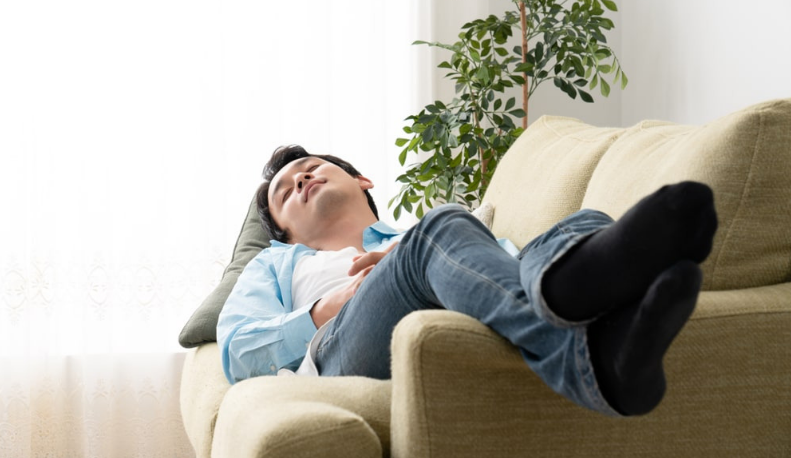Coffee naps have become popular these days, but do they actually help? For those who want to give it a try, coffee naps consist of drinking a cup of coffee or other caffeinated beverage in a short space of time and immediately lying down for a nap. But this seems to be contradictory to everything we’ve previously heard about how caffeine affects sleep.
So how do coffee naps help to make you feel more awake? It’s all related to a chemical called adenosine. After working for a couple of hours, your body naturally produces adenosine. This chemical fits into adenosine receptors in the brain, and once it has done so, you will start to feel tired.

When you drink coffee, the caffeine moves through the stomach and into the bloodstream before reaching the brain. Once the caffeine has reached the brain, it latches onto any available adenosine receptors, blocking the path for adenosine to latch onto the receptor, which makes you feel more awake.
So where does the nap come in? By drinking coffee quickly and immediately taking a nap, your body releases adenosine and makes way for caffeine to take its place.
Do Coffee Naps Actually Work?
A study conducted by the National Institute of Medicine found that coffee naps are effective in improving attention and reducing fatigue. Another study proved that a coffee nap was far more effective in improving alertness and reducing sleepiness than napping without the addition of caffeine.
A study conducted over 24 hours tested the effectiveness of coffee naps and sleep deprivation. Participants stayed awake for 24 hours, only taking short naps every couple of hours. Some participants drank caffeine before their naps. The placebo group drank a non-caffeinated beverage before their naps. After the naps, participants took performance tests that measured their vigilance sensitivity and logical reasoning.

Participants in the placebo group had significantly worse test results the longer they were awake in comparison to their baseline test results. Those taking coffee naps had no reduction in their test results in comparison to their baseline. These results suggest that coffee naps are quite effective at helping people remain alert and rested.
While the study is useful in measuring the effectiveness of a coffee nap, this type of behavior will lead to sleep deprivation with many negative impacts on your health.
Benefits of Coffee Naps
There are many benefits to coffee naps. Let’s take a look at the ways they can help improve performance.
Improved Mood
Napping has been shown to improve mood, alleviate impulsive behavior and relieve feelings of frustration. With the addition of caffeine, you will feel more alert after napping, ensuring you don’t feel the continued urge to sleep. Read the ultimate guide to naps to ensure you’re following napping best practices.
Enhanced Focus
Studies have shown that coffee naps can enhance people’s ability to focus by making them feel less tired. This helps people get back to work and increase their productivity.
Increased Alertness
Coffee naps can make people feel more alert and awake. However, this does not mean that we recommend staying awake for unnecessarily long periods of time, as this will lead to the accumulation of sleep debt.
Increased Productivity
In this 2003 study, coffee nappers were more productive than those who took a nap without caffeine. If you work from home, taking an afternoon coffee nap could be just what you need to give you a boost in productivity toward the end of your workday.
How to Take a Coffee Nap
In order for the coffee nap to be the most effective, you’ll want to pay attention to a few key elements. Let’s take a closer look.
How Long to Nap
Johns Hopkins recommends napping between 20 and 40 minutes. But it’s best to keep coffee naps between 20 and 30 minutes long, because caffeine reaches peak effectiveness within 15 and 30 minutes after consumption.

This also gives your body enough time to release adenosine, leaving you feeling awake but not groggy. Also, a 20-30 minute nap won’t give you so much rest that you can’t fall asleep when bedtime arrives.
The Right Amount of Caffeine
The studies referred to earlier in this article all used 200 mg of caffeine to test the results of coffee naps. If you are caffeine sensitive, it’s best to start with a smaller amount of caffeine and work your way up over time.
It’s best not to consume more than 200 mg of caffeine at once to ensure your intake is not above 400 mg per day. Consuming too much caffeine can be detrimental to your health and impact your sleep.
Sleep Environment
During your coffee nap, ensure that you are creating a healthy sleep environment. This includes dimming lights, closing curtains and ensuring the room is quiet.
FAQs
Can you sleep after drinking coffee?
It is possible to sleep after drinking coffee, as caffeine only reaches peak effectiveness 15-30 minutes after consumption.
How long should a coffee nap be?
The ideal amount of time for a coffee nap is between 20 and 30 minutes. This gives your body enough time for adenosine (a chemical that makes you feel tired) to be released from the adenosine receptor and replaced with caffeine.
Are coffee naps a thing?
Yes, coffee naps are a thing, and they are growing in popularity. Many studies have shown the effectiveness of consuming caffeine before a short nap.
How much coffee do you put in a coffee nap?
Most studies conducted on the effectiveness of coffee naps used 200 mg of caffeine. However, if caffeine makes you feel jittery and anxious, it’s better to try a coffee nap with less caffeine.

